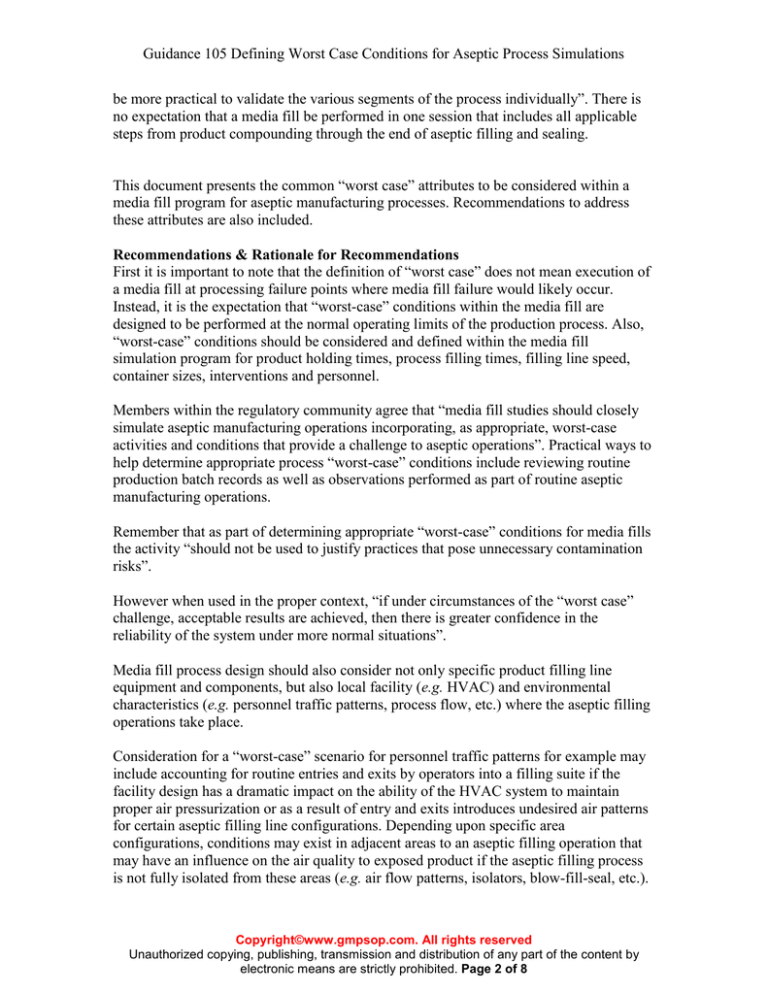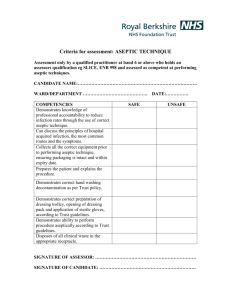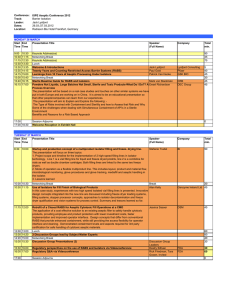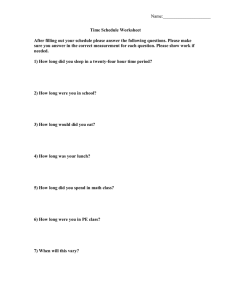Defining Worst Case Conditions for Aseptic Process
advertisement

Guidance 105 Defining Worst Case Conditions for Aseptic Process Simulations be more practical to validate the various segments of the process individually”. There is no expectation that a media fill be performed in one session that includes all applicable steps from product compounding through the end of aseptic filling and sealing. This document presents the common “worst case” attributes to be considered within a media fill program for aseptic manufacturing processes. Recommendations to address these attributes are also included. Recommendations & Rationale for Recommendations First it is important to note that the definition of “worst case” does not mean execution of a media fill at processing failure points where media fill failure would likely occur. Instead, it is the expectation that “worst-case” conditions within the media fill are designed to be performed at the normal operating limits of the production process. Also, “worst-case” conditions should be considered and defined within the media fill simulation program for product holding times, process filling times, filling line speed, container sizes, interventions and personnel. Members within the regulatory community agree that “media fill studies should closely simulate aseptic manufacturing operations incorporating, as appropriate, worst-case activities and conditions that provide a challenge to aseptic operations”. Practical ways to help determine appropriate process “worst-case” conditions include reviewing routine production batch records as well as observations performed as part of routine aseptic manufacturing operations. Remember that as part of determining appropriate “worst-case” conditions for media fills the activity “should not be used to justify practices that pose unnecessary contamination risks”. However when used in the proper context, “if under circumstances of the “worst case” challenge, acceptable results are achieved, then there is greater confidence in the reliability of the system under more normal situations”. Media fill process design should also consider not only specific product filling line equipment and components, but also local facility (e.g. HVAC) and environmental characteristics (e.g. personnel traffic patterns, process flow, etc.) where the aseptic filling operations take place. Consideration for a “worst-case” scenario for personnel traffic patterns for example may include accounting for routine entries and exits by operators into a filling suite if the facility design has a dramatic impact on the ability of the HVAC system to maintain proper air pressurization or as a result of entry and exits introduces undesired air patterns for certain aseptic filling line configurations. Depending upon specific area configurations, conditions may exist in adjacent areas to an aseptic filling operation that may have an influence on the air quality to exposed product if the aseptic filling process is not fully isolated from these areas (e.g. air flow patterns, isolators, blow-fill-seal, etc.). Copyright©www.gmpsop.com. All rights reserved Unauthorized copying, publishing, transmission and distribution of any part of the content by electronic means are strictly prohibited. Page 2 of 8 Guidance 105 Defining Worst Case Conditions for Aseptic Process Simulations This would allow a physical testing method in lieu of having to perform on a routine basis a specific holding of sterilized media within the bulk tank for the site prescribed maximum holding time period between sterilization until the initiation of aseptic filling. This additional simulation process would not be required if the pressure hold test is routinely performed, which demonstrates that the sterile bulk holding tank maintains integrity. For example, the holding time simulation could be performed on an annual (e.g. regular) basis and combined within a scheduled aseptic filling media fill process and would be performed to assess the continued capability of the operators to perform critical manipulations that could affect the sterility of the bulk product at this stage of manufacture. Remember that other compounding activities that involve “any aseptic manipulations performed during and at the end of the holding period” such as sampling, weighing, multiple filtrations, etc. should also be included in the design of a bulk holding time simulation. Obviously, in the event of a process change, additional holding time simulation(s) would be indicated to support the change in the process that may have an impact on the bulk holding tank operation. 2. Aseptic Process Times: The time it takes to perform all necessary aseptic processing operations is a major consideration in media fill design. The maximum aseptic process filling time required to fill the largest batch size for any given container/closure size should also include other activities that are part of a normal aseptic processing operation (e.g. operator breaks, necessary equipment change-outs, etc.). The most conservative position or “worst-case” for assessing the required time to complete a media fill operation would be the full batch size and duration since it most closely simulates the actual production operation. Other media fill design options can be used and may include performing the media fill immediately following the completion of routine production operations, which is also known as “piggybacking”, or alternating the filling of media fill vials with just operating the filling equipment (without vial filling) to allow for continuous processing time while minimizing the total number of media filled vials. This provides an acceptable alternative for a “worst-case” scenario to simulate the maximum anticipated filling time. In this situation, the containers should at a minimum be filled at the start of the filling run and at the end of the desired filling time to fully encompass operation. In any case, a supporting rationale document should be generated that explains the duration of a media fill process simulation in the event that the anticipated duration differs from the actual filling process duration. Any rationale that is developed for aseptic operations that do not employ true personnel separation from the process (e.g. restricted access barriers, isolators, blow-fill-seal) “should be carried out so as to cover all shift operations” since the introduction of new Copyright©www.gmpsop.com. All rights reserved Unauthorized copying, publishing, transmission and distribution of any part of the content by electronic means are strictly prohibited. Page 4 of 8 Guidance 105 Defining Worst Case Conditions for Aseptic Process Simulations fill is recommended the longest anticipated continuous filling operation period between operator breaks. 8. Process Setup: The media fill program “should be designed to detect potential contamination from set-up activities” as the setup of a filling operation inherently is a “worst-case” condition in any aseptic filling operation since it may involve a great deal of direct operator intervention into the immediate filling area. 9. Interventions: The media fill for any aseptic manufacturing process “should represent a “worst case” situation and include all manipulations and interventions likely to be represented during a shift”. Process interventions can be considered to be either routine (typical) or non-routine (atypical) in nature. Routine interventions are those that occur in most processing operations (e.g. line set-up, fill weight adjustments, addition of stoppers, removal of downed vials, sampling, environmental monitoring, etc.). Non-routine interventions occur sporadically and do not necessarily occur during every production batch. Non-routine interventions of this type include unexpected processing equipment failures or any occurrence that hinders routine operations of the process (e.g. line jams, vial guide adjustments, removal and replacement of damaged components, etc.). Non routine interventions should be included in the intervention plan of the media fill program and performed at least once per year. Media fill documentation “should list all interventions that are permitted during normal batch processing”. It is important that the “interventions representative of each shift, and shift changeover, should be incorporated into the design” of a media fill. However, remember that “justifying mechanical interventions through environmental monitoring and media fills is not a good practice; the process design focus should be on eliminating interventions”. The media fill should not be used to justify poor practices. The frequency to perform an intervention during a media fill should also be representative of the number of times the intervention occurs in an aseptic manufacturing operation9. Conclusions The media fill program design should consider and is expected to “emulate the regular product fill situation in terms of equipment, processes, personnel involved and time taken for filling as well as for holding”. As part of media fill design, there is an expectation to consider “worst case” conditions. A number of these have been presented including: holding times, aseptic process times, number of units, line speed, container size, process matrix, personnel, process setup, and interventions. Within each of these highlighted categories an attempt has been made to provide guidance on what to consider a “worstcase” condition within the media fill program. Remember that “worst-case” conditions are expected to be included within the media fill program, but there is a certain degree of latitude in how you can accomplish implementing these conditions. Copyright©www.gmpsop.com. All rights reserved Unauthorized copying, publishing, transmission and distribution of any part of the content by electronic means are strictly prohibited. Page 7 of 8


